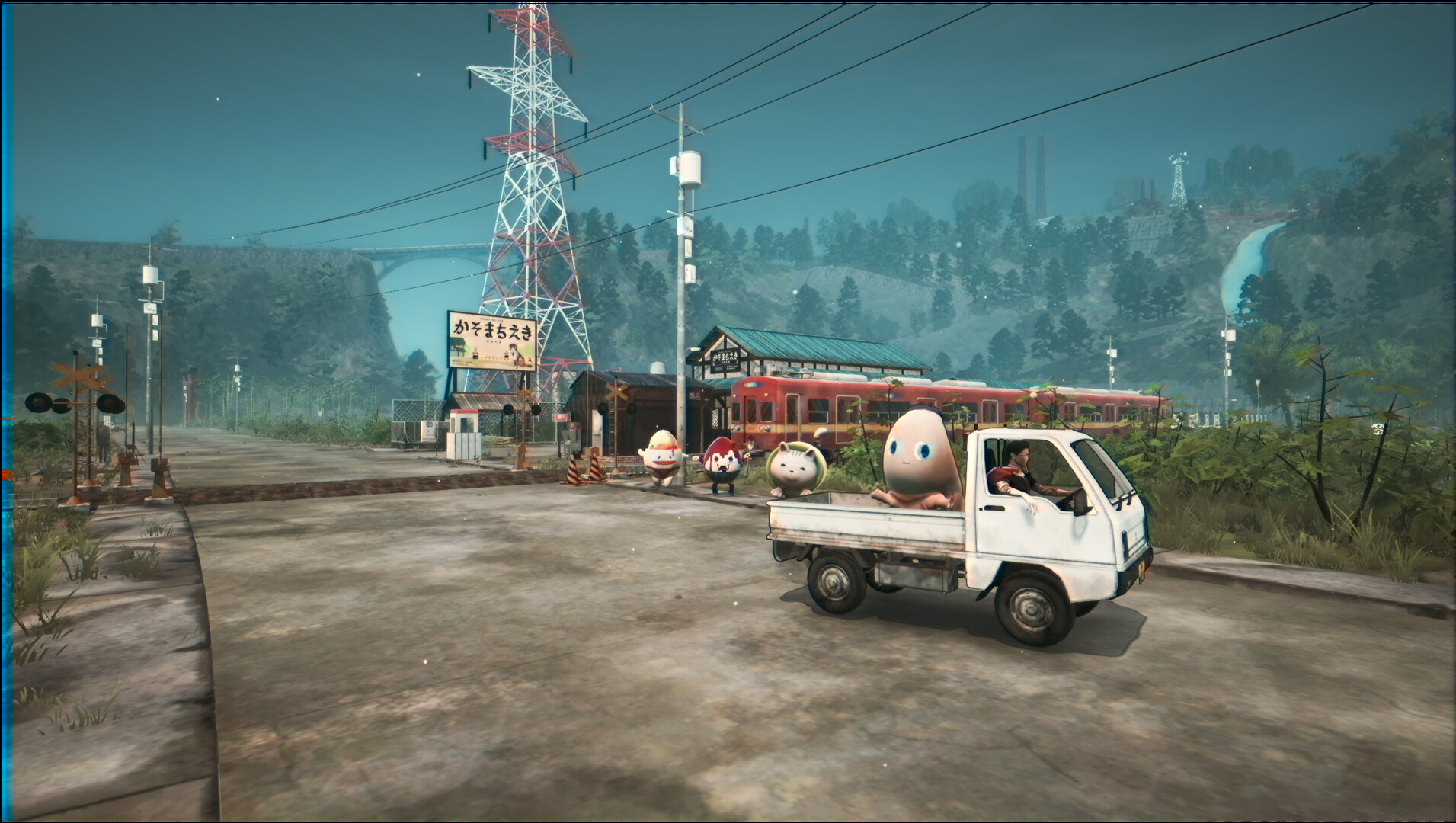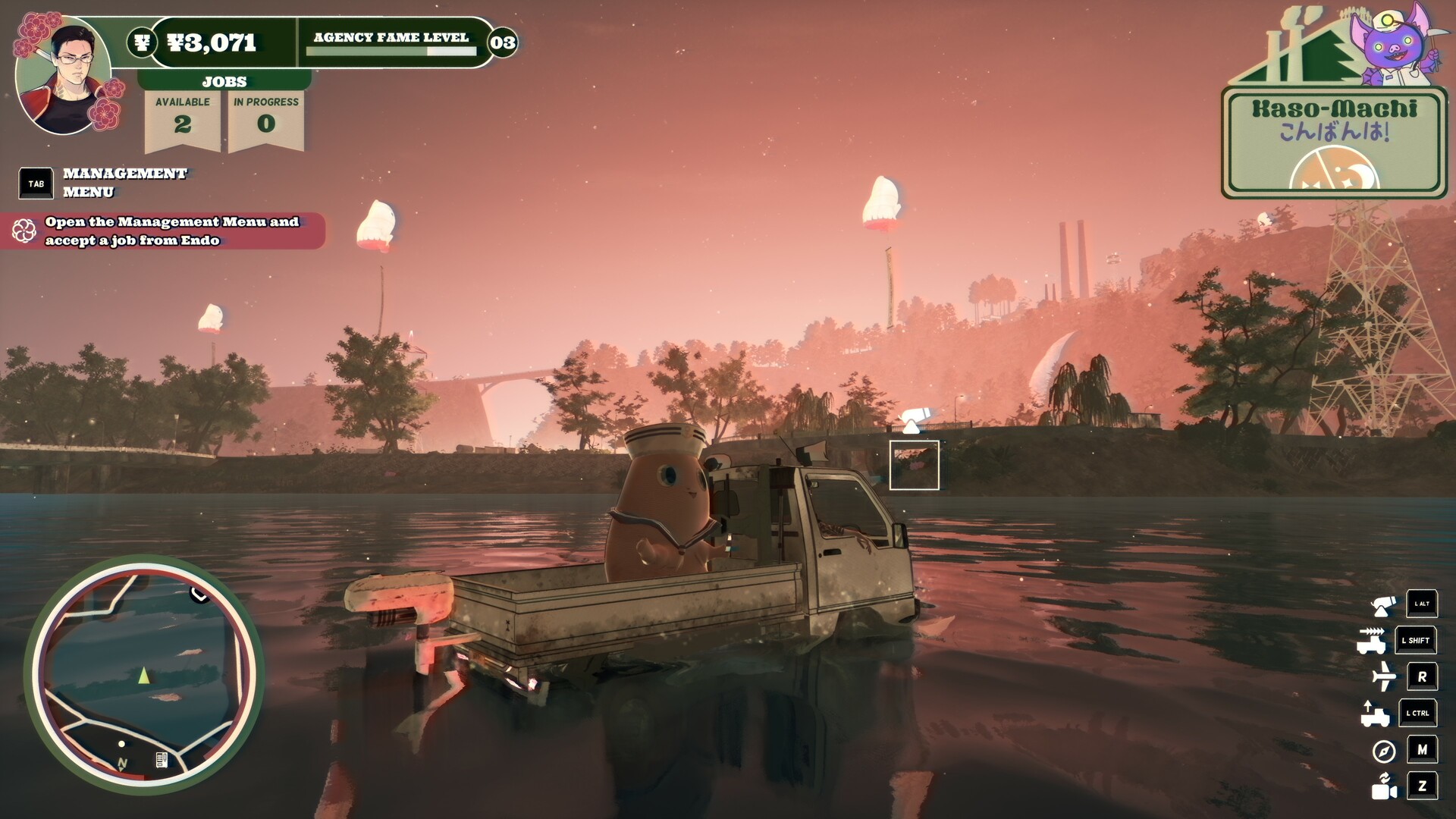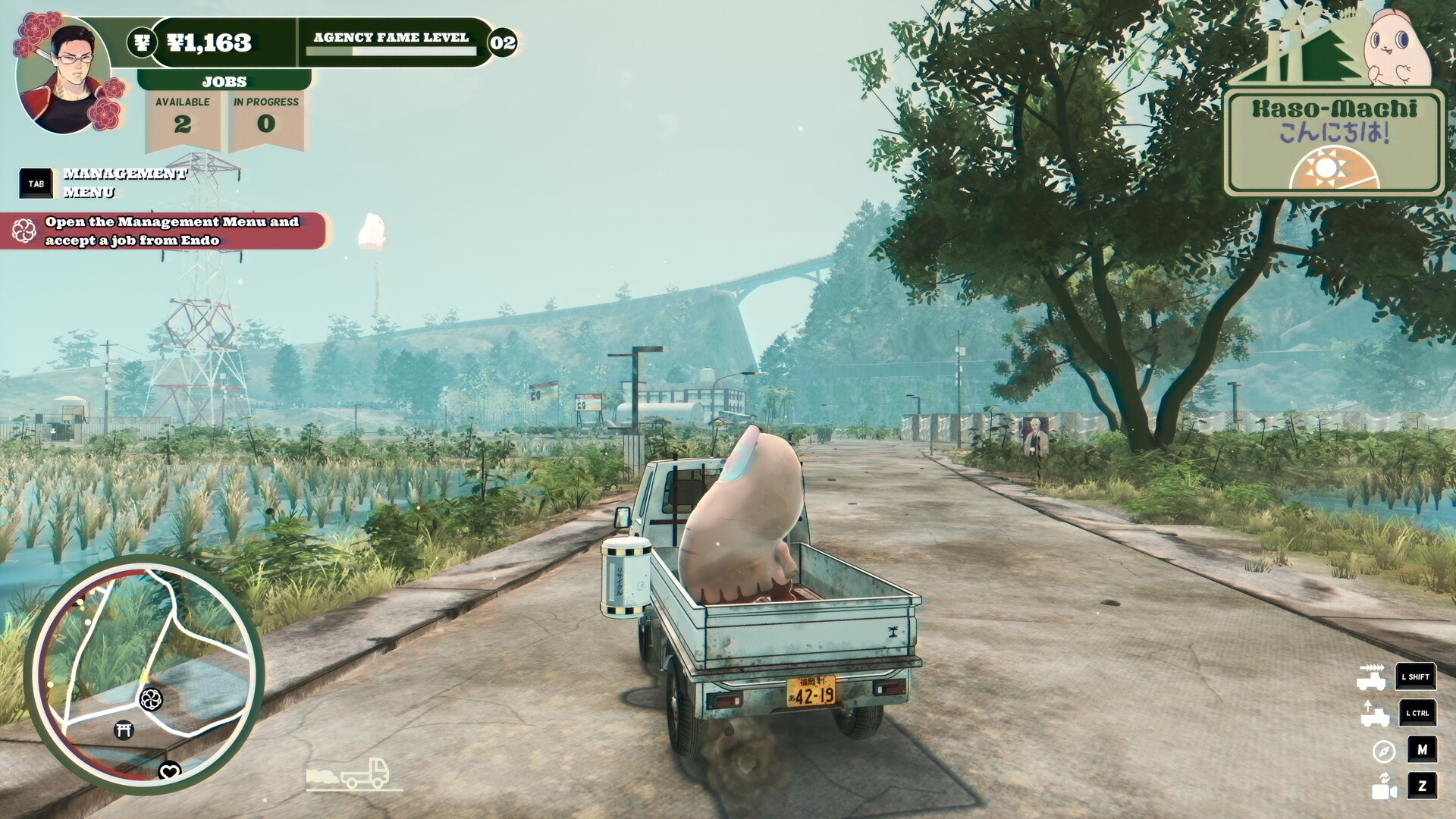Promise Mascot Agency Interview – Setting, Mascot Management, Progression, and More
With an elevator pitch describing it as an open world mascot management crime drama game, Promise Mascot Agency is clearly a game that’s positioning itself as quite a unique experience. Developer Kaizen Game Works is promising an offbeat open world adventure with an emphasis on humour, management simulation, exploration, and more, and it’s fair to say that the game has turned a few heads. To learn more about what exactly Promise Mascot Agency will bring to the table, we recently had the chance to send across a few questions about the game to its developers. Below, you can read our interview with Kaizen Game Works’ Phil Crabtree.
“The game has a good amount of serious crime drama and very heartfelt story, but we always want to make games that are funny and silly.”
It’s fair to say that we don’t see too many open world mascot management crime dramas, which is what you’ve described Promise Mascot Agency as. How did that idea first come about?
The idea for a mascot management game came first, from our art director, Rachel. At the time, she envisioned it as a 2D Kairosoft-like but we wanted to do something bigger and stranger. We were working on pitching this game and I just threw the yakuza story in there so we had something in a pitch deck. We expected to change it later but it stuck. It has given us a very unique concept, with lots of room to explore different ideas.
From what we’ve seen of the game so far, it’s clear that humour and whimsy are very much going to be part of the equation. How heavily does the game emphasize such elements, tonally speaking?
The game has a good amount of serious crime drama and very heartfelt story, but we always want to make games that are funny and silly. Some of the team’s favourite games are campy Resident Evils, Yakuza and PS2 games like Disaster Report. These all deal with serious subject matter, but are also funny and silly in places. None of us are particularly enamoured with humourless, gritty games, so we always want to make something that puts a smile on the player’s face.
True to the game’s name, it looks like meeting and managing mascots will be key to the experience. Can you tell us how this will contribute to the story?
The player assumes the role of Michi, an exiled yakuza lieutenant, forced to save a bankrupt mascot agency in order to pay back a huge debt. This means that the mascots are absolutely key to the story. Without them, Michi will fail and his family will fall prey to their rivals.
Michi is a fish out of water, he has never run an agency before and has a lot to learn. His assistant manager, Pinky is a mascot herself, and she will guide him through the trials and tribulations of mascot management.
The mascots that Michi meets out in town will also help him. Not only will they go out to work, they will offer their own views on how to improve the business, as well as helping Michi discover more about himself. Some mascots are essential to the story. The town of Kaso-Machi holds a dark secret and Michi will need the help of his mascots to uncover it.
From a gameplay perspective, how extensive will the management mechanics be, where the mascot management side of the experience is concerned?
The management simulation drives everything in the game. Everything you do either feeds back into the simulation or is enabled by the simulation. The core of the management is recruiting mascots and sending them out to mascot events. These earn money and fans, as well as improving the stats of each mascot. Earning money allows the player to invest in businesses around town to open up more business opportunities. Earning more fans raises the profile of the agency and also attracts more business. The more famous you are, the more mascots are interested in working with you and the more events open up.
Your fame level also increases your notoriety with the Mysterious Masked Figures that run the Mascot Ranking Association. They will allow you to open up extra arms of your business, giving you the opportunity to expand into subcontracting work in other towns and operating a mascot merchandise business.
All of the side content in the game feeds into the management simulation as well. NPCs will reward you helping them by becoming Mascot Support Heroes, selling you Mascot Help Items and improving truck to enable you to explore more of the world.
As well as this, all of the mascots have their own hopes and dreams. As their boss, you will need to help them achieve those dreams and in doing so, you will improve the mascot performance and open up more aspects of the simulation to manage.
“Michi is a fish out of water, he has never run an agency before and has a lot to learn. His assistant manager, Pinky is a mascot herself, and she will guide him through the trials and tribulations of mascot management.”
What will the progression mechanics in the game look like? How can mascots power up and improve over the course of the game?
There are three main types of progression; mascot improvement, business growth and open world exploration.
Mascots improve based on the perks you choose to give them when you recruit them, their job performance and if you help them with their side quests. They have a number of stats like Popularity and Motivation that determine how they perform in their job. These are improved when jobs go well and when you spend time hanging out with them, pursuing their side quests. The better their stats, the less likely they are to get in trouble while working and earn better rewards.
As the business grows, more of the game opens up. More NPCs want to talk to you, the story progresses and new gameplay becomes available. Everything in the game feeds into business growth; collectables, side quests, exploration, conversations and the day and night cycle all change the management simulation.
The open world of Kaso-Machi has a lot of secrets to discover, and all of these feedback into the game progression. Shrines can be tidied, sins cleansed and the influence of the corrupt mayor reduced. The player can’t access all parts of the world at the start of the game and will need to speak to the town’s mechanic to unlock truck upgrades to gain access to new areas. The truck can be upgraded to glide, turn into a boat and fire Pinky at barriers to open up new areas.
What can you tell us about the game’s open world setting? How large will the map be, and how have you approached the side content that it will offer?
The game takes place in the beautiful, but creepy town of Kaso-Machi. This town lies off the coast of Kyushu and has suffered for years under the corruption of the mayor. It is nearly deserted, businesses are closed and a yakuza hunting curse hangs over the island.
The island is relatively large, but densely packed. It is dominated by a mountain and the player will wind their way through mountain roads, speed by rice fields and explore rundown shopping streets.
There is a lot of side content to discover, all of it affecting the player’s business in different ways. The player will need to explore to find Mascot Support Heroes to help their mascots when they get into trouble. They’ll also be able to cleanse the sins of the town, help a mascot build a game center, find the station master’s stray cats, chase down mountain spirits for truck upgrades and much more.
The guiding principle with designing the game is that EVERYTHING must affect the core simulation. Rather than busy work for achievements, all side content must improve the player’s business.
What can you tell us about the Hero Cards mechanic, and how it will impact gameplay from a tactical perspective?
When a mascot goes out on a job, they might get in trouble. This takes many forms; getting stuck in doorways, falling down stairs, being harassed by stalkers and hunted by dreadful nightmare spirits.
When a mascot gets in trouble, you need to use hero cards to help them. These hero cards represent the townsfolk of Kaso-Machi coming together to help the mascot. Each type of trouble has a different style; Confidence, Environment, Malfunction etc. Each hero is suited to help with different types of trouble. Players will need to chain combos of hero cards together to whittle down the health of these obstacles to happiness and help the mascot carry on. If a mascot can’t be saved, they will be unhappy and the job rewards will be dramatically decreased.
Roughly how long will an average playthrough of the game be?
We think it will take about 30 hours to 100% the game and somewhere between 10 and 20 for the main story and a bit of side content.
“The game takes place in the beautiful, but creepy town of Kaso-Machi.”
Given that you have experience working with all the current-gen consoles, I was hoping to pick your brain on some of the differences between them. For instance, where their GPUs are concerned, the PS5 clocks in at 10.28 teraflops, behind the Xbox Series X’s 12 teraflops. In real terms, however, how much of an impact does that difference have during development?
Promise Mascot Agency, and Paradise Killer are more graphically intensive than a lot of indie games built by small teams just because they’re 3D, open world, and feature dynamic lighting with a full day night cycle (and Paradise Killer now has RayTracing too!), but we do try to build the games to work across as many devices as possible including lower end ones. Typically getting the game running on the lower end platforms is much more time consuming for us than building for the current gen due to the nature of optimisation, but we always like to keep in mind the power they offer and build in enough flexibility to make sure we can up the quality for the players on those platforms and hit target resolution / framerates.
When it comes to the differences between the GPU’s on the PS5 and Xbox Series X, we’re not developing at a visual fidelity where we really need to push those systems so for us, the difference between the two isn’t as noticeable as it would be for other developers, but we do enjoy the fact we can up the quality for those platforms.
The PS5 features an incredibly fast SSD with 5.5GB/s raw bandwidth. How can developers take advantage of this, and how does this compare to the Xbox Series X’s 2.4GB/s raw bandwidth?
It’s really game dependent. For us, that super fast SSD means we get low load times and streaming becomes almost a non-issue. We’re loading the whole game world in about 1.5 seconds currently, which would have been unthinkable before this tech became readily available. On Paradise Killer we had to modify the UI around the world loading sequence on PS5 because it was just so fast.
It’s nice to have bandwidth limitations lifted with very little effort on our side as it does make development that much easier, but it is still difficult for smaller developers to build interesting gameplay experiences which take advantage of that performance unless you’re in a position just to target one platform.
Both the PS5 and Xbox Series X boast Zen 2 CPUs, but there is a difference in the processors of both consoles. The Xbox Series X features 8x Zen 2 Cores at 3.8GHz, whereas the PS5 features 8x Zen 2 Cores at 3.5GHz. Your thoughts on this difference?
For the games we make, both these CPU’s more than cover what we need so it’s just great to know that we can really turn up values in the game to take advantage of the performance. We write our games mostly in C++ so, with the help of Unreal, we’re able to spread the load of the open-world simulation, audio, VFX, physics, etc. across those cores. Just being able to do that makes releasing on these platforms easier for us.
The Xbox Series S features lesser hardware compared to Xbox Series and Microsoft is pushing it as a 1440p/60 FPS console. Do you think it will be able to hold up for the more graphically intensive games as this generation progresses?
I think it’s safe to say that games will still scale pretty well to fit the hardware. We know the Series X is more powerful than the Series S so there will be some differences, but it can still result in very solid game play experiences even if there is some difference visually.
What frame rate and resolution will the game target on the PS5 and Xbox Series X/S?
Promise Mascot Agency is targeting 4k/60 on PS5 and Xbox Series X, and 1440p on the Xbox Series S.





Comments are closed.